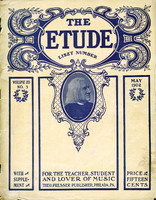A correspondent asks for information on the above subject, saying: “Owing to the severe cold to which some of our organs are subject, where churches are not heated during the week, when the reeds are always more or less out of tune, it would certainly be a most useful thing for organists to be able at least temporarily to tune a few of the most turbulent stops so that the service for the day could be rendered at least fairly well.”
The reeds are the most sensitive and delicate part of the speaking section of an organ, and one should think twice before touching them unless one has a thorough knowledge of their properties. However, sometimes a little attention from a delicate hand will greatly improve the tone of a pipe or cause a silent reed to speak and be of some use.
If a reed is silent it may be due to several causes, the principal of which are: dirt on the tongue, or the tuning-wire is driven down too far, or the tongue is out of place. On removing the pipe take off the boot and see if any dirt is visible; in which case a thin piece of clean paper passed gently over the tongue and between the tongue and the reed will oftentimes correct the trouble.
If this is of no avail, place the pipe in its position and with a screw-driver or some other long and somewhat weighty tool slightly strike the tuning-wire from below, thus driving it up till the pipe speaks; then tune it by driving it back again, striking it, always gently, on top of the tuning-wire. When the pipe is in tune try it in comparison with the pipes above and below for power, as the tuning-wire not only tunes the reed, but regulates the power of the tone. Sometimes the reed will become silent, as the tongue is driven down before the pipe is quite in tune; in such cases if the tone is not too loud the pipe can be tuned by raising or lowering the bell on top of the pipe, or if there is no bell by raising or lowering the tuning-slit at the top of the pipe.
If the reed is very refractory and does not respond to this treatment the boot should be removed, and by holding the reed up on a level with the eyes see if the tongue is square in its position, and if the tongue curls up a little and evenly as it should. To remove the tongue draw the tuning-wire down off the tongue and remove the little wooden peg which holds it in place with a knife. The tongue can then be thoroughly cleaned with a piece of clean tissue- paper and replaced. One should be careful that the tongue is replaced squarely over the slit in the reed and fastened in tightly.
All the above operations are dangerous unless one is very careful and particular not to do too much, and many reeds have been spoiled by careless tinkering of thoughtless operators. With care and judgment one can many times bring a refractory reed into line, while a little rough handling will completely spoil it for all time.—E. E. T.



